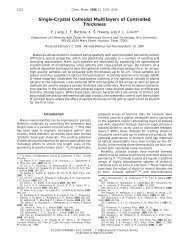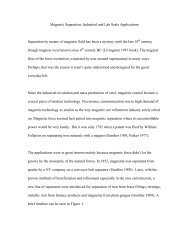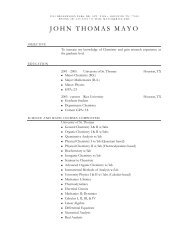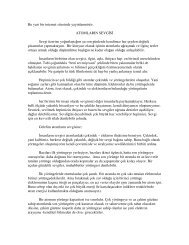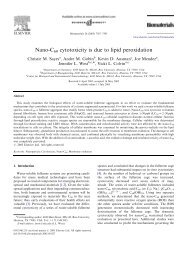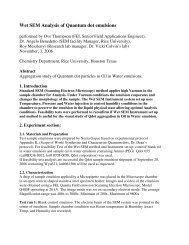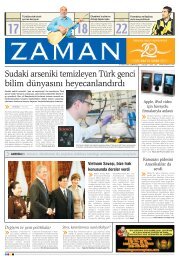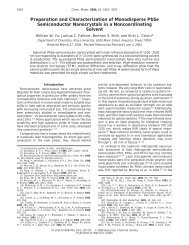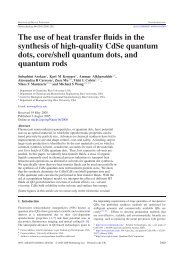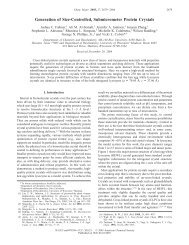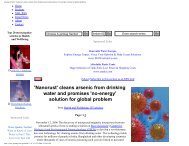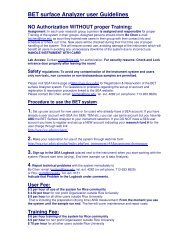Photodegradation of Congo Red catalyzed by nanosized TiO2
Photodegradation of Congo Red catalyzed by nanosized TiO2
Photodegradation of Congo Red catalyzed by nanosized TiO2
Create successful ePaper yourself
Turn your PDF publications into a flip-book with our unique Google optimized e-Paper software.
54 R.K. Wahi et al. / Journal <strong>of</strong> Molecular Catalysis A: Chemical 242 (2005) 48–56<br />
ing discussion, because the determination <strong>of</strong> t1/2 required fewer<br />
calculations and approximations than the determination <strong>of</strong> k.<br />
3.2.1. Effects <strong>of</strong> particle size and surface area<br />
The kinetic data for the spherical dot-shaped anatase catalysts<br />
(A1, A2, and A3) indicated that particle size and surface<br />
area were the two most important factors influencing the photocatalytic<br />
activity <strong>of</strong> nanocrystalline <strong>TiO2</strong> catalyst (Table 2). The<br />
t1/2,m for the 15.1 nm (A3) and 10.1 nm (A2) nanodots were both<br />
about 1.5 min g, while t1/2,m for the 5.5 nm nanodots (A1) was<br />
40 min g. Thus, 10–15 nm nanodots with low to intermediate surface<br />
areas (80–150 m 2 g −1 ) were about 25 times more active than<br />
5.5 nm nanodots with very high surface area (251 m 2 g −1 ). This<br />
shows that despite the larger number <strong>of</strong> surface sites available<br />
for <strong>Congo</strong> <strong>Red</strong> adsorption onto smaller nanodots, the increased<br />
recombination rate <strong>of</strong> e − /h + in very small particles resulted in<br />
an overall decrease in photocatalytic activity. The 10.1 nm nanodots<br />
<strong>of</strong> A2 (t1/2,m = 1.5 min g) were slightly more active than<br />
the 15.1 nm nanodots <strong>of</strong> A3 (t1/2,m = 1.75 min g), indicating that<br />
A2’s larger surface area contributed more in photocatalytic activity<br />
than electron–hole separation when the particle was big<br />
enough (>10 nm). It appears to be an optimal particle size <strong>of</strong><br />
about 10 nm for a maximum photocatalytic activity <strong>of</strong> anatase<br />
nanodots.<br />
3.2.2. Effect <strong>of</strong> phase composition<br />
3.2.2.1. Single-phase catalysts: anatase versus rutile. The<br />
single-phase anatase catalysts exhibited widely varied activities<br />
that appeared to depend not only on particle size and surface area<br />
but also on the surface (crystal) structure. It can be concluded<br />
from t1/2, data that anatase <strong>TiO2</strong> is a better photocatalyst than<br />
rutile <strong>TiO2</strong>. The t1/2, values for the anatase <strong>TiO2</strong> were found to<br />
be about 2–100 times smaller than that <strong>of</strong> the 5.4 nm R1 rutile<br />
nanodots, indicating that the surface <strong>of</strong> anatase is better to photocatalysis<br />
than the surface <strong>of</strong> rutile. Thus, the generally superior<br />
photocatalytic activity <strong>of</strong> anatase is not merely a result <strong>of</strong> the typically<br />
easy-achieved larger surface areas, but rather a result <strong>of</strong> the<br />
fundamental differences between the anatase and rutile surfaces<br />
(crystal structures). Specifically, the poor activity <strong>of</strong> R1 suggests<br />
that even a moderately high surface area (110 m −2 g −1 ) cannot<br />
compensate for the inefficient hole trapping and low adsorptive<br />
affinity that typically related with rutile’s inherent crystal structure.<br />
The adsorption isotherms in Fig. 1 showed the low adsorptive<br />
affinity <strong>of</strong> rutile <strong>TiO2</strong> for <strong>Congo</strong> <strong>Red</strong>, thus, lowered the<br />
activity <strong>of</strong> R1 in photocatalytic degradation <strong>of</strong> <strong>Congo</strong> <strong>Red</strong>. In<br />
addition, the low apparent adsorption constant K obtained from<br />
Langmuir–Hinshelwood analysis for R1 (K = 0.027) confirms its<br />
low adsorptive affinity.<br />
3.2.2.2. Synergetic effect <strong>of</strong> anatase–rutile mixed-phase <strong>TiO2</strong><br />
catalysts. Our experiments confirmed the strong synergetic<br />
effect in enhancing the photocatalytic activity <strong>of</strong> P25. In the<br />
terms <strong>of</strong> t1/2 and k, it was found that P25, an anatase–rutile mixture<br />
with an intermediate surface area (50 m 2 g −1 ), was more<br />
active than A2, a pure-anatase powder with higher surface area<br />
(153 m 2 g −1 ), <strong>by</strong> a factor <strong>of</strong> 2.5. Thus, it is clear that the pres-<br />
ence <strong>of</strong> two phases in P25 resulted in a remarkable increase in<br />
photocatalytic activity over pure-anatase <strong>TiO2</strong>.<br />
However, this synergetic effect was not apparent in the ultrafine<br />
anatase–rutile mixture AR1 and AR2 (∼5 nm) despite<br />
their high surface areas (123–232 m 2 g −1 ). They were even<br />
less active than pure-anatase A2 and A3. The t1/2 and<br />
Langmuir–Hinshelwood rate constant k supported this observation.<br />
There are several possible reasons for the absence <strong>of</strong> synergetic<br />
effect in our anatase–rutile mixtures. First, the photocatalytic<br />
activity <strong>of</strong> such mixtures depends in part on the relative<br />
amounts <strong>of</strong> these two phases. Bacsa and Kiwi reported that a<br />
highest activity for p-coumaric acid degradation was observed<br />
for an anatase/rutile ratio <strong>of</strong> 70/30 [29]. It is possible that AR1<br />
exhibited low photocatalytic activity because <strong>of</strong> not-optimized<br />
anatase/rutile ratio (40/60). However, AR2 performed almost<br />
the same activity as AR1 even its anatase/rutile ratio (70/30)<br />
was close to that <strong>of</strong> P25 (80/20) and equal to the optimal composition<br />
reported <strong>by</strong> Bacsa and Kiwi.<br />
A more important factor is likely the anatase–rutile interface<br />
in these two catalysts. The enhancement <strong>of</strong> activity in Degussa<br />
P25 has been attributed to efficient electron transfer from rutile<br />
to anatase, which increases the charge separation needed for<br />
efficient photocatalytic reaction at the particle surfaces [33].<br />
Well-contacted interfaces between the anatase and rutile phases<br />
would thus be essential for an appreciable increase in photocatalytic<br />
activity for any mixed-phase catalysts [32,48]. But the<br />
anatase–rutile interfacial contacts in AR1 and AR2 may not be<br />
well controlled as P25. And the smaller size (5 nm) in AR1 and<br />
AR2 may not be good for the electron-hole separation for a high<br />
activity (see Section 3 for A1).<br />
3.2.3. Effect <strong>of</strong> morphology on the activity <strong>of</strong> anatase <strong>TiO2</strong><br />
catalysts<br />
<strong>TiO2</strong> nanorods (Rod1 and Rod2) performed significantly<br />
worse than the anatase nanodots (A2 and A3) (Table 2). Specific<br />
activities, as quantified <strong>by</strong> t1/2, and k, indicated that nanorods<br />
were 5–10 times less active than the 10–15 nm nanodots. FTIR<br />
spectroscopy confirmed the complete removal <strong>of</strong> surfactant from<br />
the nanorods samples prior to the photocatalytic experiments<br />
(Fig. 5), so surfactant poisoning or retarding could be ruled<br />
out as a reason for the poor performance <strong>of</strong> the Rod1 and<br />
Rod2 catalysts. The surface areas accounted partially for the<br />
differences in their per mass activities, but cannot account for<br />
all the activity difference. A (1 0 1) surface dominated <strong>TiO2</strong><br />
was obtained <strong>by</strong> selective binding <strong>of</strong> the tetramethylammonium<br />
cation (N(CH3)4 + ) to the (1 0 1) surface, which inhibited<br />
the growth in the [1 0 1] direction and promoted the growth in<br />
perpendicular directions [44]. The higher the surfactant concentration,<br />
the more pronounced this anisotropic effect. So, the<br />
dominated (1 0 1) surface sites in Rod1 and Rod2 seemed unfavorable<br />
to the photocatalytic activity <strong>of</strong> <strong>TiO2</strong>.<br />
The deleterious effect <strong>of</strong> (1 0 1) surfaces on photocatalytic<br />
activity could be derived from the water adsorption modes to<br />
different anatase surfaces. Theoretical calculations have indicated<br />
that water molecules tend to adsorb dissociatively (i.e., as<br />
H + and OH − ) to anatase (0 0 1) but non-dissociatively (i.e., as



